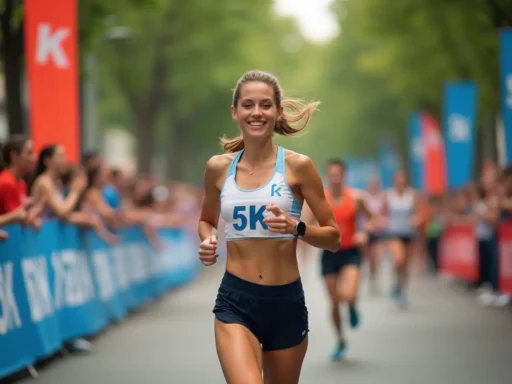How far is a 5k? You might wonder, how far is it? A 5K is 5 kilometers, or 3.1 miles. Knowing this distance is key to getting ready for the race. It helps you plan your training, whether you’re experienced or new to running.

Remember, the distance is just the start. With at least eight weeks of training, you can run over 10 miles a week. This means you can increase your weekly distance by 10 percent to stay safe. So, a 5K is 3.1 miles, a goal you can reach with hard work and a good training plan.
Table of Contents
What Exactly is a 5K Race?
A 5K race is a 5-kilometer or 3.1-mile run. It’s shorter than a marathon. Fast runners can finish in 15 to 17 minutes, while others take 25 to 28 minutes.
5K races are common and happen all year. In the U.S., you can find charity runs, festive races, and community events. They’re great for beginners because they’re not too long.
Origin of the 5K Distance
The 5K started in cross-country running. Now, it’s a popular road race. Many use it as a first step to longer races.
Popular 5K Events in America
Big 5Ks in America include the Boston 5K, New York City 5K, and Chicago 5K. These events draw thousands of runners, offering a fun and competitive vibe.
Why 5K is Perfect for Beginners
The 5K is ideal for new runners. It’s challenging but achievable. Completing a 5K gives a huge sense of accomplishment. It’s also a good way to build endurance before tackling longer races.
| Age Group | Average Finishing Time (Women) | Average Finishing Time (Men) |
|---|---|---|
| 1-14 | 24:43 | 21:24 |
| 15-19 | 23:06 | 18:57 |
| 20-29 | 20:58 | 17:49 |
| 30-39 | 20:49 | 18:02 |
| 40-49 | 22:19 | 19:02 |
| 50-59 | 24:11 | 20:02 |
| 60-69 | 27:47 | 23:05 |
| 70-100 | 38:25 | 28:27 |
How Far is a 5K in Different Measurements
When you ask how far is a 5k in miles, the answer is about 3.1 miles. Let’s look at this distance in different ways. A 5K is 5,000 meters or 3.10686 miles. It’s also 5 kilometers, with 1 kilometer being 0.621371 miles.
Here are the conversions for a 5K in various units:
- 5,000 meters
- 3.1 miles
- 16,404 feet
- 5 kilometers
Knowing these measurements helps you get ready for a 5K race. For example, on a standard outdoor track, you need to run 12.5 laps to reach 5K. Understanding how far is a 5k helps set goals and track your progress.
Whether you’re new to running or have experience, knowing the 5K distance in different ways improves your training. So, when someone asks how far is a 5k, you can give a precise answer. You’ll impress others with your knowledge.
Getting Started with 5K Training
To start your 5K training, first understand the distance. A 5K is 3.1 miles, or about 5 kilometers. Before you begin, check your current fitness level. This will help you find a good starting point.
Beginners should start with short runs, like 5-minute ones, followed by walks. As you get better, increase your running time and how often you run. A good training plan lasts about six weeks, aiming to finish the 5K by the end.
Assessing Your Current Fitness Level
Check your fitness by looking at your running experience, health, and any physical limits. This helps you make a plan that fits you. Start by running or walking three times a week, cross-training twice, and resting two days.
Setting Realistic Training Goals
Set goals you can reach, like running a 5K in under 30 minutes. Use pace calculators to track your progress and stay motivated. Many beginners aim to run a 5K in under 30 minutes, which is about a 10-minute mile pace.
Building a Training Schedule
Make a schedule with varying run lengths. The last week should include runs up to 30 minutes with intervals to improve your running. Include rest days or cross-training to avoid burnout and injury. Always listen to your body and adjust your plan as needed for a great 5K experience.
Essential Gear for 5K Training
Getting ready for your 5K training means having the right gear. The right shoes, clothes, and accessories can really help. Investing in quality gear can prevent injuries and make your runs better.
Finding the right running shoes is key. Brands like Asics, Brooks, and Nike have many options. Look for shoes that support your arches, cushion well, and grip the ground. Also, non-cotton running socks help avoid blisters and bruises by keeping your feet dry.
Here are some must-have items:
- Running shoes from reputable brands
- Non-cotton running socks
- Breathable running clothing
- Performance watches or fitness trackers
- Reflective gear for visibility

Choose clothes that fit the weather and your style. Layering clothing helps keep you cool or warm. Technical running tops with moisture-wicking fabrics keep you dry. With the right gear, you’re set for a great 5K training journey.
| Gear Item | Price Range | Features |
|---|---|---|
| Running Shoes | $60-$150 | Arch support, cushioning, traction |
| Non-Cotton Socks | $10-$20 | Moisture-wicking, breathable |
| Running Tops | $20-$50 | Moisture-wicking, reflective |
Building Your Base Mileage
Starting your 5K training means focusing on building your base mileage. You need to slowly increase your weekly runs to boost endurance and stamina. Aim to raise your weekly mileage by no more than 10% each week. For instance, if you run 10 miles a week, you can go up to 11 miles the next week.
Here are some weekly mileage targets to help you:
- If you run less than 15 miles a week, 3 runs a week are okay.
- If you run between 15-25 miles a week, you should do at least 4 runs a week.
- For more than 25 miles or runs, you need even more.
Weekly Mileage Requirements
Finding the right balance between training and rest is key. Aim for 80-90% of your training to be at an easy pace. This helps your body adjust to running without risking injury.
Proper Pace Management
Managing your pace is crucial when building your base mileage. Run at a pace that feels comfortable, not too hard. Try to run 1-2 minutes slower than your goal pace. For example, if you aim for an 8-minute mile, run at 9-10 minutes per mile.
Recovery Between Runs
Recovery between runs is vital for your body to heal and adapt. Make sure to rest well, eat right, and stay hydrated. Prioritizing recovery helps prevent injuries and boosts your performance.
Nutrition Strategies for 5K Success
As you get ready for your 5K, it’s key to focus on proper nutrition. A balanced diet with the right carbs, protein, and fat is crucial. It helps you power through training and reach the finish line strong.
Make sure to eat enough calories each day. Aim for a mix of:
- 45-55% carbohydrates
- 15-20% protein
- 25-35% fat

This mix keeps your energy up and supports your muscles.
Before your race, have a light, carb-rich snack like a banana or granola bar. Drink 180-240 mL of water every 15-20 minutes. Stay away from dairy, fried foods, and sugary snacks to avoid stomach problems.
After the race, eat recovery meals with carbs and lean protein. This helps repair your muscles. With the right nutrition, you’ll hit your 5K goals and feel strong at the finish.
Common 5K Training Mistakes to Avoid
Starting your 5K training journey? It’s key to know common mistakes that can slow you down or hurt you. Avoiding these pitfalls will keep you on track and help you reach your goals.
Big mistakes include overtraining, which can make you tired and less effective. Also, bad form can cause pain and injuries. And don’t forget, nutrition errors can affect your energy and health.
Overtraining Risks
Overtraining is a big mistake with serious effects. It’s important to listen to your body and not overdo it, especially at the start. A good balance of rest, training, and nutrition is key for top performance.
Improper Form Issues
Bad form can cause pain, injuries, and lower your performance. It’s crucial to focus on proper running techniques like posture, foot strike, and breathing. This keeps you running smoothly and safely.
Nutrition Errors
Nutrition is vital for your 5K training. Proper hydration and fueling keep your energy up and support your body. Don’t make common mistakes like skipping refueling after a run or not drinking enough water.
Race Day Preparation Tips
Getting ready for your 5K race is key to doing your best. Arrive 60 minutes before the race to settle, warm up, and get ready mentally. A 15-minute easy run and 10 minutes of stretching can boost blood flow and ease muscle tension.
A good warm-up should include strides, short fast runs. Do 3 sets of 30 seconds, 35-45 minutes before the race. This raises your heart rate and gets your muscles ready. Also, drink lots of water and electrolyte-rich fluids to stay hydrated.
It’s important to start at a pace that feels right, 5-10 seconds slower than your goal pace. As the race goes on, you’ll need to push harder to keep your pace. Here are some tips to remember:
- Start slow to avoid running out of steam too soon
- Focus on one competitor at a time to stay motivated
- Give it your all for the last 800 meters to finish strong
Success in a 5K comes from both physical and mental preparation. Follow these tips and stay focused. You’ll be on your way to reaching your goals and crossing the finish line with confidence.
Advanced Training Techniques
As you get better at 5K training, it’s key to use advanced methods. One great way is to add speed work to your routine. This could be 10-12 x 400 meters, 8 x 600 meters, or 6 x 800 meters, with breaks in between. For instance, the 10-12 x 400 meters workout might have 200 to 300 meters of jogging to recover.
Hill training is another advanced method. It boosts your running efficiency and endurance. Try hill sprints for 8-12 seconds at full effort, with full recovery in between. Do this 1-2 times a week after easy runs. Also, adding cross-training like cycling or swimming can lower injury risk and boost fitness.
Speed Work Sessions
- 10-12 x 400 meters with recovery jogs of 200-300 meters
- 8 x 600 meters with recovery jogs of 300-400 meters
- 6 x 800 meters with recovery jogs of 400-500 meters
Hill Training Benefits
Hill training makes your running better and safer. It reduces injury risk and boosts performance. By adding hill sprints and other advanced techniques, you can reach new heights in your 5K training.
Mental Preparation Strategies
Getting ready for your 5K means focusing on your mind. Visualization techniques can boost your confidence by up to 25%. Also, positive affirmations can cut down on negative thoughts by 30% during races. Many runners use these mental tricks to beat race-day jitters, with 58% relying on them.
To get better mentally, try breaking the 5K into smaller parts. This makes it feel more doable by 40%. Mindful breathing can also help, reducing stress by about 15% during tough times like a 5K. Plus, running for a good cause can make you feel more powerful, with 65% of runners saying they felt more driven.
Some top mental prep strategies include:
- Using mental mantras, like “feelings aren’t facts,” to fight negative thoughts
- Counting as a way to distract yourself and do better
- Focusing on your running form to speed up
- Noticing your surroundings to ease mental pressure
Adding these mental strategies to your training can help you run better and reach your 5K goals. Stay focused, manage stress, and boost your confidence to succeed.
| Mental Preparation Strategy | Benefits |
|---|---|
| Visualization techniques | Increase confidence levels by up to 25% |
| Positive affirmations | Reduce negative self-talk by 30% during races |
| Mindful breathing | Reduce perceived stress levels by approximately 15% during high-intensity activities |
Tracking Your Progress
As you keep training for your 5K, it’s key to track your progress. This helps you stay motivated and adjust your plan as needed. Running apps can be great for this, as they track your distance, pace, and heart rate.
Using Running Apps
Many running apps are out there, like Nike Run Club, Runkeeper, and Strava. They help you track your progress and set new goals. These apps offer GPS tracking, personalized coaching, and ways to share your runs.
Recording Training Metrics
It’s also vital to record your training metrics. This includes distance, pace, and heart rate. Use a log or spreadsheet to track these and see where you can get better.
Setting New Goals
Tracking your progress lets you set new goals. Maybe you want to run farther or faster. It’s important to have goals that are realistic and to celebrate your wins. Here are some tips for setting goals:
- Make your goals specific and measurable
- Set realistic and achievable goals
- Celebrate your successes along the way
- Adjust your goals as needed based on your progress
By tracking your progress and setting new goals, you can stay motivated. This will help you reach your 5K training goals.
| Week | Distance | Pace |
|---|---|---|
| 1 | 3 miles | 10:00 min/mile |
| 4 | 4 miles | 9:30 min/mile |
| 7 | 5 miles | 9:00 min/mile |
Recovery and Injury Prevention
When training for a 5K, recovery and injury prevention are key. Proper recovery techniques can lessen muscle soreness and boost performance. Studies show that strength training can cut injury risk by up to 50%. Flexibility exercises also increase your range of motion by about 20%, helping you run better and stay injury-free.
To avoid common injuries, listen to your body and don’t overdo it. Overtraining often leads to injuries. Stick to the “10% rule” to avoid increasing your weekly mileage too fast. Here are some tips for recovery and injury prevention:
- Add strength training to your routine, focusing on core, glutes, and legs
- Include flexibility exercises like stretching and foam rolling to improve range of motion and reduce soreness
- Ensure enough rest and hydration for muscle recovery, aiming for 7-9 hours of sleep and plenty of water
- Gradually increase your training to avoid overtraining and prevent injuries
By focusing on recovery and injury prevention, you can lower your injury risk and enhance your performance. Always consult healthcare professionals if you feel pain or discomfort. And don’t hesitate to take rest days when needed. With a balanced training plan and proper recovery, you’ll be ready for a successful 5K finish.
| Recovery Technique | Benefits |
|---|---|
| Strength Training | Reduces injury risk by up to 50% |
| Flexibility Exercises | Increases range of motion by approximately 20% |
| Proper Hydration | Aids in muscle recovery and reduces muscle soreness |
Your Journey to 5K Success Starts Now
Your 5K journey has just begun. With the right mindset and preparation, you’ll reach the finish line soon. The key to success is being consistent. Stick to your training plan, listen to your body, and celebrate your progress.
Don’t get discouraged by setbacks or challenges. They’re a normal part of the journey. Use them as a chance to grow stronger. Stay motivated by setting goals, tracking your progress, and being part of a supportive community.
Embrace the journey and the sense of accomplishment you’ll feel when you reach your 5K goals. Your success is within reach. Lace up your shoes and get ready to conquer the distance. The finish line is waiting, and your journey starts now.
FAQ
What is the distance of a 5K run?
A 5K run is about 3.1 miles. It’s a favorite for both fun and serious runners.
How long does it typically take to train for a 5K?
Training time for a 5K varies based on your fitness. But, most plans suggest 8-12 weeks of regular training.
What are the benefits of running a 5K?
Running a 5K boosts your heart health and endurance. It helps with weight control and gives you a sense of achievement. It’s also a great way to start running and feel more confident.
What is the origin of the 5K distance?
The 5K started in track and field as the 5,000-meter run. Now, it’s a popular road race for all levels of runners.
What are some popular 5K events in the United States?
In the U.S., top 5K events include the Peachtree Road Race in Atlanta and the Carlsbad 5000 in California. Turkey Trot events around Thanksgiving are also favorites.
Why is the 5K distance perfect for beginners?
The 5K is great for new runners. It’s challenging but not too long. It helps build endurance for longer races.
How do I convert a 5K distance to miles?
To convert 5K to miles, multiply by 0.62. So, 5 kilometers is about 3.1 miles.
What are the key steps to getting started with 5K training?
To start 5K training, first check your fitness level. Then, set goals and create a training plan. This plan should slowly increase your running distance and intensity.
What type of gear do I need for 5K training?
For 5K training, you’ll need good running shoes and clothes that wick away moisture. Don’t forget a water bottle, socks, and a heart rate monitor or fitness tracker.
How can I avoid common 5K training mistakes?
Avoid overtraining and poor form. Also, watch what you eat. Listen to your body, increase training slowly, and focus on proper technique and nutrition.




